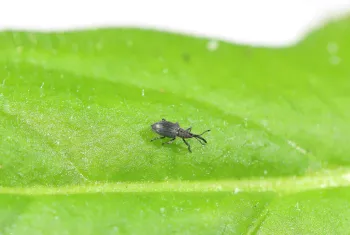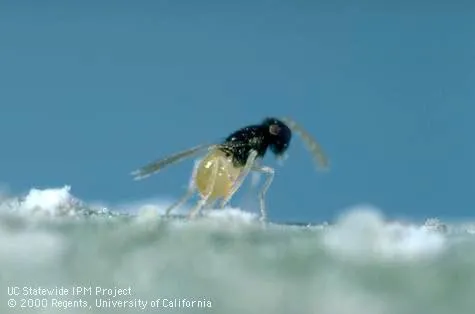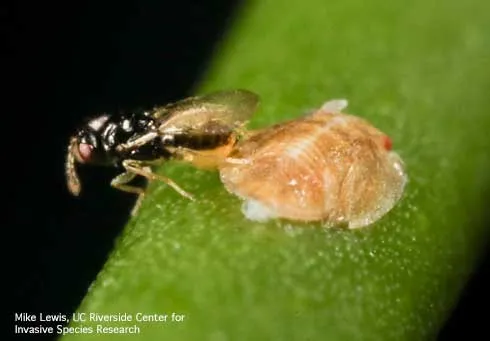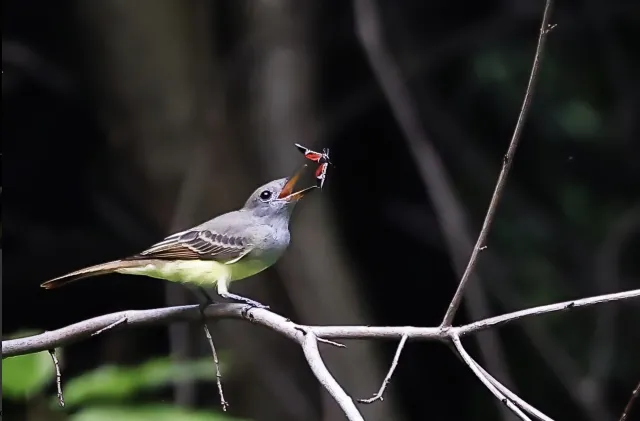In Part 1 of this story, we covered some basics of biological control. Now let’s talk about some of the good bugs helping to control invasive pests in California.

Controlling yellow starthistle one weevil at a time
Yellow starthistle (YST) is a harmful invasive plant that is established and widespread in California. Researchers from the United States Department of Agriculture (USDA) and the California Department of Food and Agriculture (CDFA) have worked to identify, release, and monitor several biological control agents of YST. One of these species is the rosette weevil (Ceratapion basicorne). Adult weevils feed on and lay their eggs inside of YST leaves. After hatching, the larvae burrow through the plant until they reach the upper part of the root. Rosette weevils can significantly weaken or kill YST, particularly when multiple weevils infest the same plant. The rosette weevil was approved for release in California in 2019, and efforts to establish populations across the state are ongoing. For more information, visit the WeedCUT webpage about the rosette weevil and other yellow starthistle biological control agents.

Tiny wasps with a big impact
Small parasitic wasps (called parasitoids) are natural enemies that lay their eggs inside of a host organism’s body. Their larvae feed on the host, which eventually kills it. They are specialists that attack only one or a few closely related insect species, making them prime candidates for biological control. Many species of parasitoid wasps have been used to manage invasive pests in California.
Encarsia inaron is a parasitoid wasp that attacks ash whitefly, a destructive tree pest that was accidently brought to California in the 1980’s. While ash whitefly populations initially boomed, populations began to crash shortly after releases of the parasitoid in the late 80’s. The wasp has kept ash whitefly populations to low levels across California ever since, reducing the need for other controls such as using pesticides. The estimated yearly economic value of this tiny wasp is $2 million. For more information about the ash whitefly parasitoid, visit UC IPM’s webpage about Encarsia inaron and read UC Riverside’s overview of this biological control success story.

In 2011, another parasitoid wasp, Tamarixia radiata, was introduced to California to help control the Asian citrus psyllid. Since then, T. radiata has spread throughout much of Southern California where the Asian citrus psyllid occurs. T. radiata is both a predator and a parasitoid, since the adults eat immature Asian citrus psyllids in addition to parasitizing them. T. radiata has helped reduced Asian citrus psyllid populations, but ants can interfere by protecting the psyllids. When ant infestations are controlled, T. radiata can be quite effective. Read more on UC IPM’s webpage about this parasitoid.
Parasitoid wasps (including Anagyrus kamali) have also been used successfully in California to manage the pink hibiscus mealybug (Maconellicoccus hirsutus), an invasive pest of landscape plants. The pink hibiscus mealybug is currently found in only two counties, Riverside and Imperial, but it could spread to other areas of the state. It is important for new detections to be reported to CDFA so that action can be taken to control this pest, including additional releases of its biocontrol agents. To learn how you can help detect and report this pest, take the free Pink Hibiscus Mealybug in California e-learning course.

Is anything eating the invasive spotted lanternfly?
The spotted lanternfly is an invasive insect rapidly spreading across the Eastern United States. Though this pest is not currently in California, experts in the state are staying informed of ongoing research into effective biocontrol for this pest. Researchers in New York have detected fungi that infect spotted lanternfly, and several parasitoid wasp species are being evaluated by numerous researchers across the United States. Birds, mammals, fish and insects have also been seen dining on spotted lanternfly in infested regions, though unfortunately not in high enough numbers to control it.
To learn how you can help keep the spotted lanternfly out of California, take the free Spotted Lanternfly in California e-learning course.
Tiny Allies, Big Impact
From tiny weevils that target invasive weeds to parasitoid wasps that take down damaging pests, biological control agents are working behind the scenes to protect California’s environment, agriculture, and landscapes. These natural enemies offer a sustainable, targeted alternative to chemical pesticides, and many have already proven their long-term value. As new pests like the spotted lanternfly threaten to spread, researchers and agencies are staying vigilant and exploring the next generation of good bugs. By staying informed and supporting early detection efforts, we can all play a role in helping beneficial insects do what they do best.
Find out more about other “good bugs” and the pests they attack on UC IPM’s Natural Enemies Gallery pages. If you have questions about the bugs in your garden or landscape, reach out to your local UC Master Gardener Program for support! Helplines are staffed with supportive volunteers who are happy to help with insect ID and empower you with an integrated pest management plan for your green spaces.

